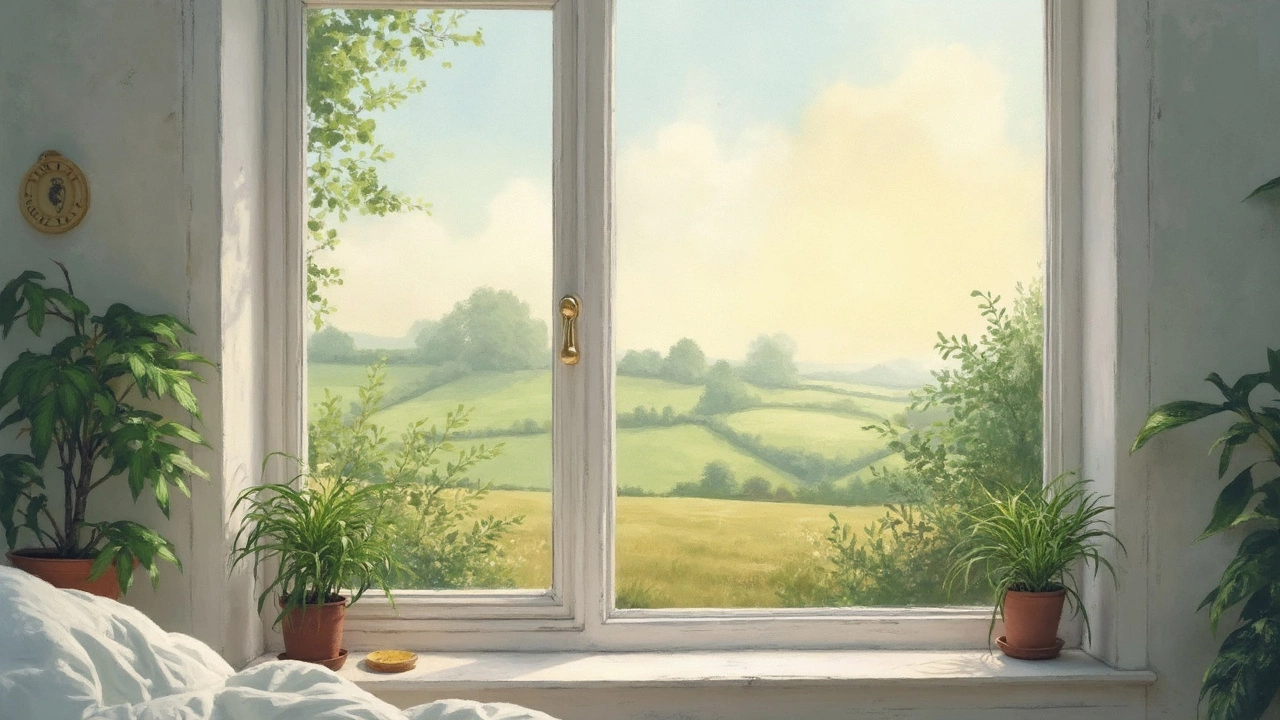Ever heard someone say it’s bad to have plants in your bedroom? It might sound a bit odd at first because, after all, don't plants give off oxygen? During the day, they’re busy converting CO2 into fresh air for us to breathe. But guess what? At night, the process flips, and most plants release carbon dioxide.
This isn’t to say your bedroom will turn into a suffocating chamber—luckily, your one or two potted plants won’t have such dramatic effects. Still, the tiny CO2 boost might not be ideal when you're trying to get some quality shut-eye.
On another note, have you ever considered the possibility of mold? Yep, that's a thing. The damp soil can be the perfect breeding ground for mold spores, which isn't cool for anyone with allergies or asthma. Maybe it's time to ensure you're taking care of that properly.
If you’re sold on greenery in the bedroom, you don't have to chuck all your plants in the bin. Picking low-maintenance plants that fit your space can make all the difference. But there are other ways to up your room's vibe without going full-on jungle mode during your sleep time, too!
- The Myths About Plant Benefits at Night
- Breathing and Sleep Quality
- Mold and Allergies
- Choosing Plants Wisely
- Alternatives to Bedroom Plants
The Myths About Plant Benefits at Night
There's a common belief that having indoor plants in your room is a surefire way to enhance air quality and boost mood, even while you're snoozing. Sounds perfect, right? But it's not the whole story. Let's take a closer look at those assumptions.
Nighttime Oxygen: Fact or Fiction?
People often think plants are natural air purifiers, tirelessly churning out oxygen 24/7. While that’s partly true during the day, nighttime is a different gig. Most indoor plants switch gears in the dark, taking in oxygen and giving off carbon dioxide. It's part of a natural process called respiration. So, the idea that your fiddly fig is an all-night oxygen machine? Not entirely accurate.
Plants and Your Sleep
Think those lilies are relaxing your mind and body as you sleep? Some believe your sleep quality could actually be affected by the tiny increase in CO2 levels thanks to your leafy friends. While a couple of plants won't smother you in your sleep, it's something to consider, especially if dozens of plants fill your bedroom.
Pure Air, Anytime?
It’s often touted that plants filter toxins, which is true to some extent. Studies from NASA back in the '80s found that certain plants, like the snake plant and aloe vera, can absorb some nasty chemicals. However, this doesn't mean you'll breathe completely clean air. Air filtration isn't as simple as adding some greenery—ventilation is key.
Wrapping your head around these myths helps set realistic expectations for what your leafy companions can achieve. Don’t write them off completely, though. While they might not work wonders overnight, they still offer plenty of benefits during daylight.
Breathing and Sleep Quality
Let's chat about what those leafy friends do in your bedroom at night. During the day, indoor plants are like mini air purifiers, soaking up carbon dioxide and pumping out oxygen. But when the sun sets, the photosynthesis process halts. Most plants then start breathing like us: they consume oxygen and release carbon dioxide.
This shift might not sound massive, but if your room is packed with plants, there could be a slight increase in CO2 levels. This isn't ideal for sleep, as higher CO2 concentrations can make the air feel a bit stuffy, potentially affecting sleep quality.
Does It Really Matter?
Okay, so we’re not talking about a jungle-grade CO2 spike here, but it's enough to make you consider moderation. Especially if your space lacks good ventilation, you'll want to limit the number of plants or opt for those known to continue oxygenating at night, like succulents or orchids.
Enhancing Air Flow
Good airflow makes a world of difference. Make sure your bedroom has a window cracked open or a fan stirring the air around. This doesn’t just benefit your night's rest—plants too appreciate a bit of fresh breeze.
Plant Choices Matter
Some bedroom plants won't disrupt your snooze. Snake plants and aloe vera, for instance, release oxygen at night and can improve air quality without the CO2 uptick from other plants. Consider these if you're set on bedroom greenery.
In short? Keep it simple, keep it airy, and choose wisely.

Mold and Allergies
Indoor plants look lovely, but sometimes they bring a friend along—mold. If your plant pots stay damp, there's a good chance mold might start growing. Mold loves moisture, and that's often found in the soil.
How Mold Develops
Mold thrives where it's humid and warm. Your home might have just the perfect conditions, especially if you’re keeping plants that require regular watering. As you water them, excess moisture may settle on the surface or beneath the soil, becoming a breeding ground for mold. So, what can you do?
- Be mindful of how much you water. Only water when necessary, and let the top layer of soil dry out between waterings.
- Use pots with drainage holes to avoid standing water. Trust me, no one likes soggy roots—that’s a mold paradise.
- Ensure good air circulation in the room. Open a window now and then!
Impact on Allergies
If you're sneezing all the time or have itchy eyes, mold could be the culprit. Spores from mold can trigger allergies and even worsen asthma symptoms. It’s more common than you might think, especially when you're cohabitating the same space as the plants.
Avoiding these irritants can be as easy as choosing the right kind of indoor plants. Some plants are naturally less prone to mold, especially those that don't need constant watering.
Easy-to-Care Options
| Plant Name | Watering Frequency |
|---|---|
| Cactus | Once every 2-3 weeks |
| Succulents | Once a month |
| Snake Plant | Every 2-3 weeks |
These options don't require as much water, minimizing the risk of mold, which makes them great choices for bedroom plants. Always prioritize keeping your health in check while enjoying some greenery.
Choosing Plants Wisely
So, you've weighed the pros and cons of having indoor plants in your bedroom, and the thought of a little greenery still appeals to you. Great! But it’s not just about slapping any old plant in there and calling it a day. Some plants are a no-go for the bedroom if you're aiming for a good night's sleep.
Low-Maintenance Plant Picks
If you're after simplicity, consider slow-growing plants that won’t hog the space. Snake plants are a hit because they’re hardy and release oxygen at night. Another solid pick is the peace lily, which not only looks pretty but also tackles pollutants.
- Snake Plant (Sansevieria): Great for oxygen, minimal care.
- Peace Lily (Spathiphyllum): Purifies air, reduces pollutants.
- Spider Plant: Suitable for forgetful waterers.
Beware of Allergens
If you’ve got sensitivities, avoid plants that might stir up your allergies. Ferns and roses look nice, but they can actually exacerbate allergies for some folks.
Mind the Pet Factor
Got a curious cat or dog? Some plants can be toxic to animals. If your four-legged friend has a penchant for nibbling, you might want to steer clear of things like lilies and ivy.
Create a Plant Schedule
Treat your plants to a little TLC by establishing a care schedule. Regular watering and cleaning will keep them—and your air—fresh. Remember, happy plants mean a happy room.
By choosing wisely, you’re not only creating an aesthetically pleasing space; you're ensuring a comfortable environment that won't mess with your sleep quality. So pick those plants smartly, and let them do their thing.

Alternatives to Bedroom Plants
Feeling the loss of those leafy companions but determined to keep your bedroom a cozy, sleep-friendly space? Don’t worry; there are plenty of fun and creative ways to spruce up your space without relying on indoor plants. You might not get the same air-purifying perks, but you can definitely hit that aesthetic sweet spot.
Embrace Minimalist Decor
Going minimalist can be a game-changer for small rooms. Think clean lines, neutral tones, and clutter-free surfaces. It’s crazy how a little less 'stuff' can make your room feel so much lighter and more inviting. Consider hanging a stylish piece of artwork or putting up a few beloved photos for a personal touch.
Use Aromatherapy for Relaxation
A touch of essential oils can create a soothing atmosphere without the upkeep of plants. Try lavender or chamomile for their calming properties. An essential oil diffuser can subtly add aromas that promote relaxation and even help with sleep.
LED Fairy Lights for Ambience
Want to add some magic? String up some LED fairy lights! They're not only energy-efficient but also fantastic for creating a warm, inviting ambiance. Hang them along your headboard or ceiling to make your room twinkle in a non-intrusive way.
Functional Furniture Pieces
Why not let your furniture double as decor? There's a growing trend in multi-functional furniture that doesn’t compromise on style. Consider a chic nightstand with built-in shelves or even an eye-catching storage bench at the foot of your bed. This way, you can keep things tidy and aesthetically pleasing.
| Alternatives | Benefits |
|---|---|
| Minimalist Decor | Requires less upkeep and creates a clean space |
| Aromatherapy | Enhances relaxation and can improve sleep |
| LED Lights | Creates ambience and uses less electricity |
| Functional Furniture | Maximizes space and adds style |
So, who says you need a jungle of bedroom plants to keep the vibe alive? With these alternatives, you can achieve a serene haven that’s both stylish and practical.
